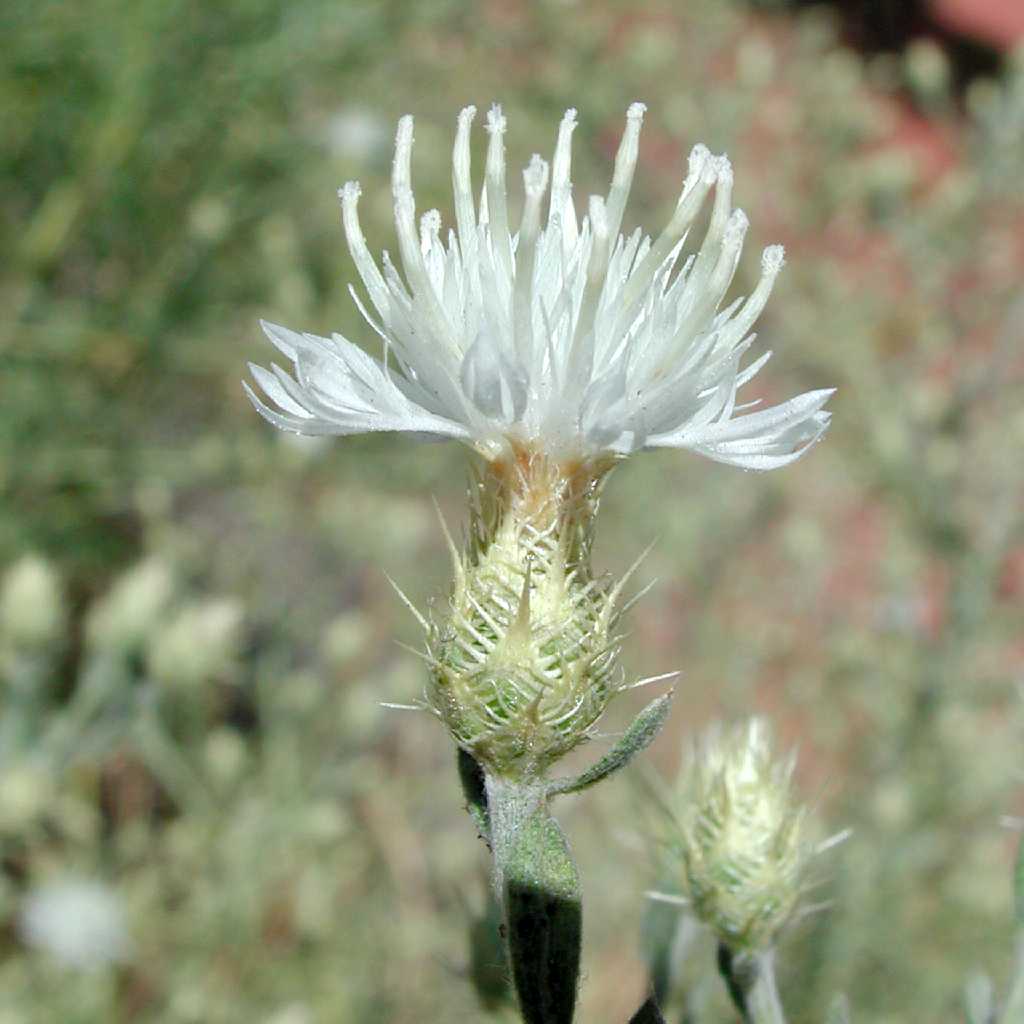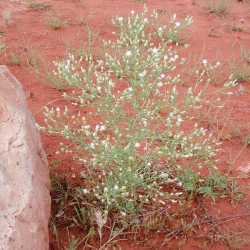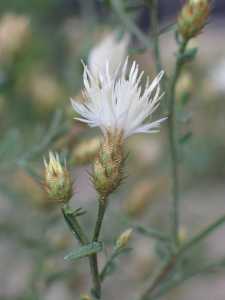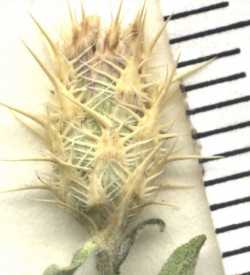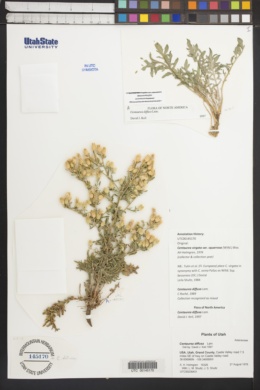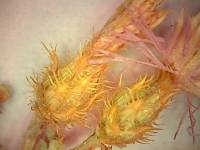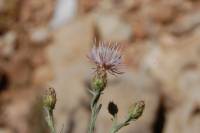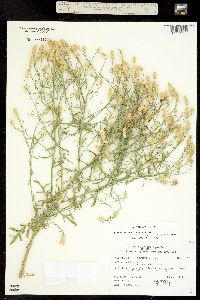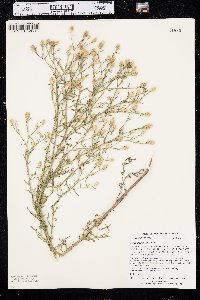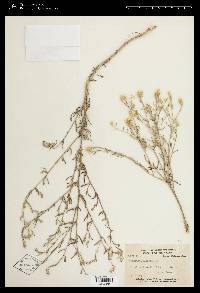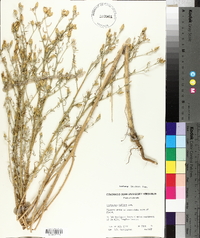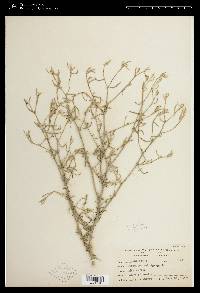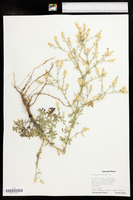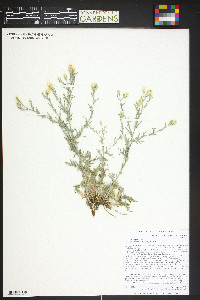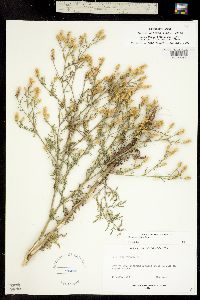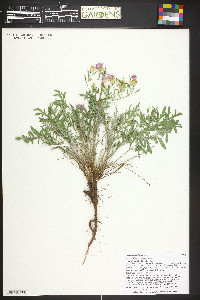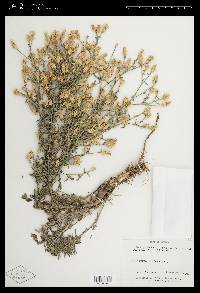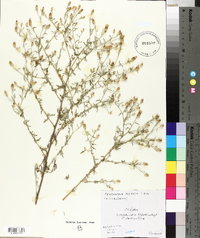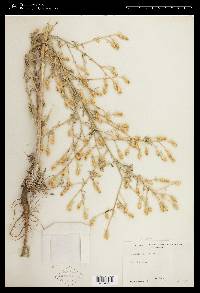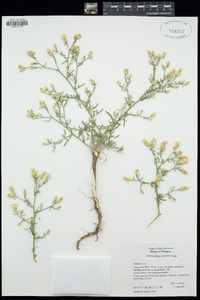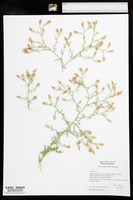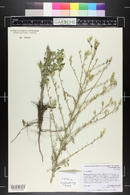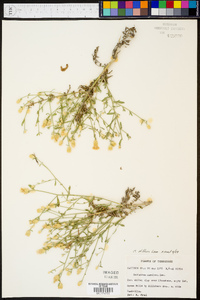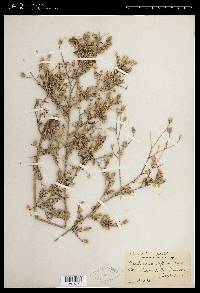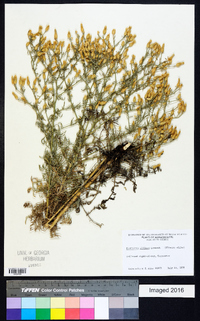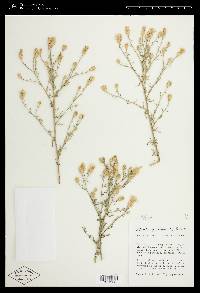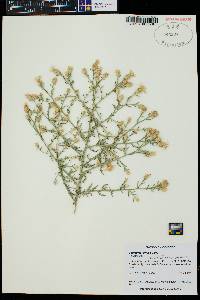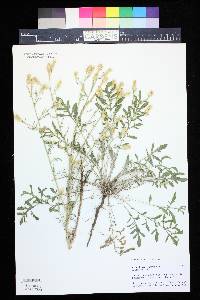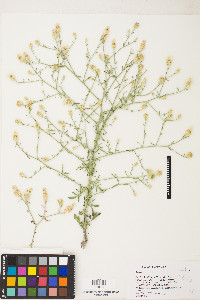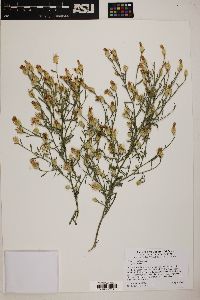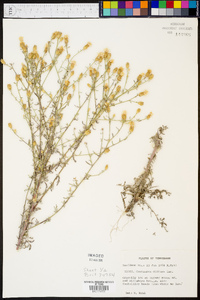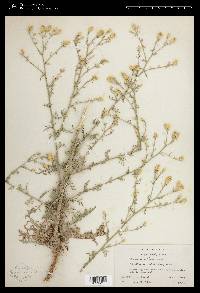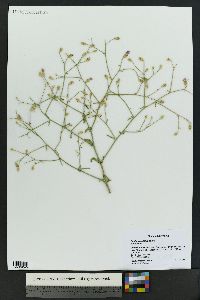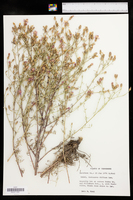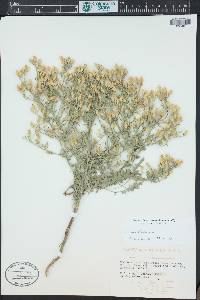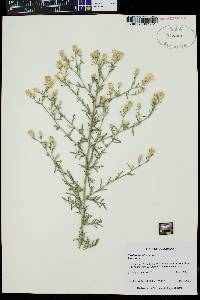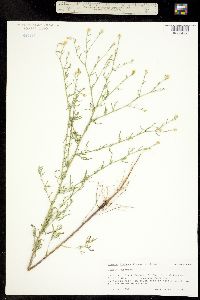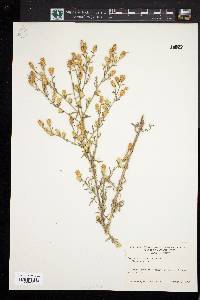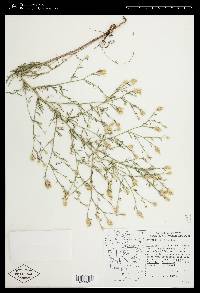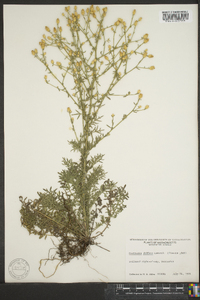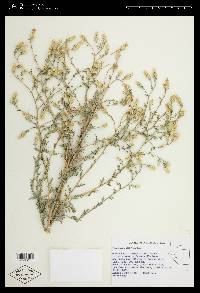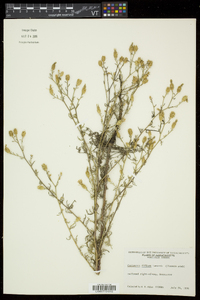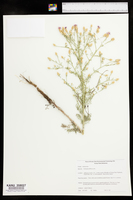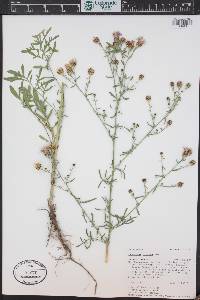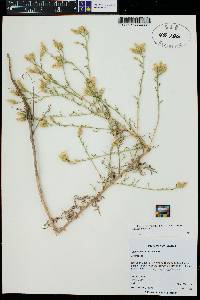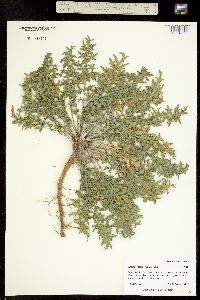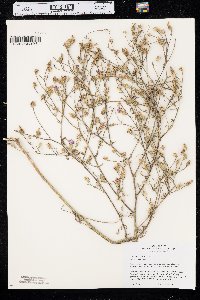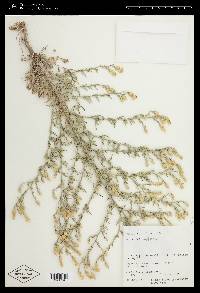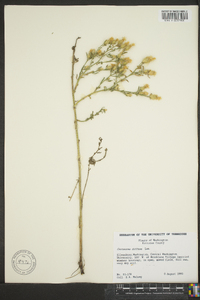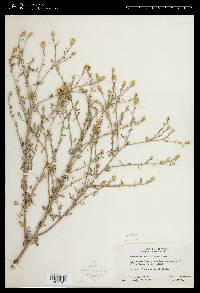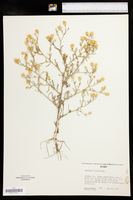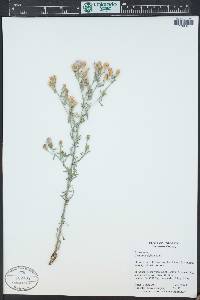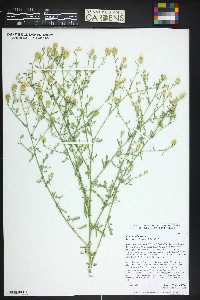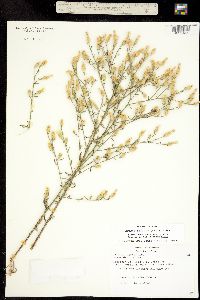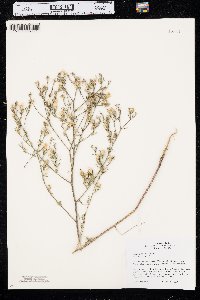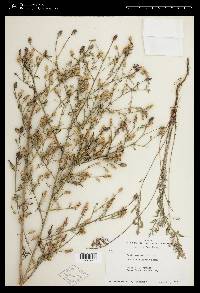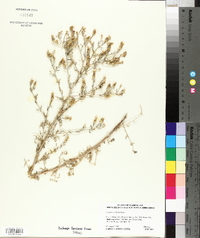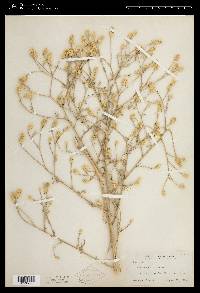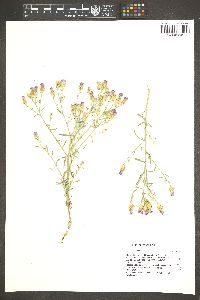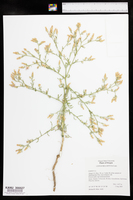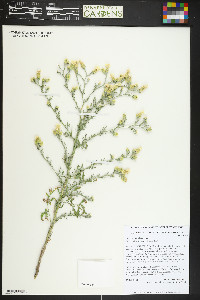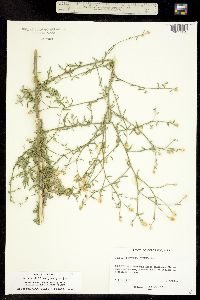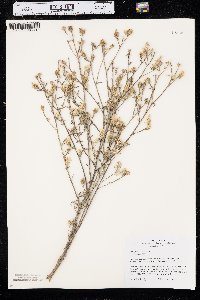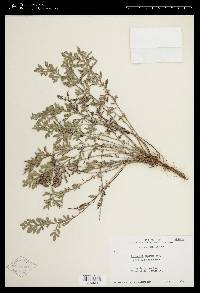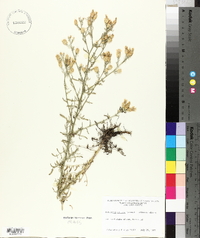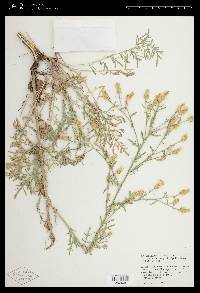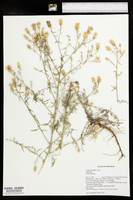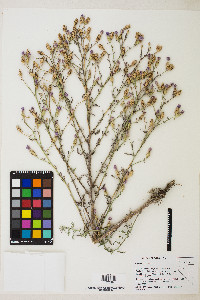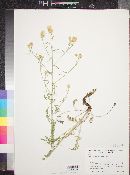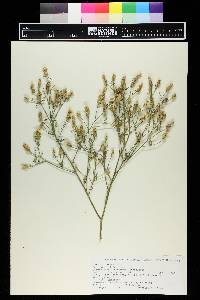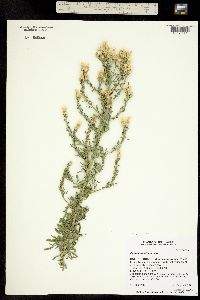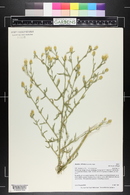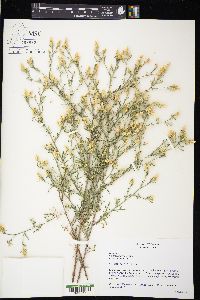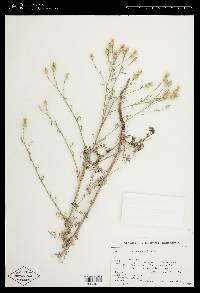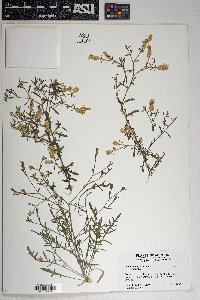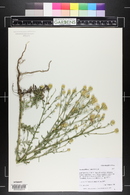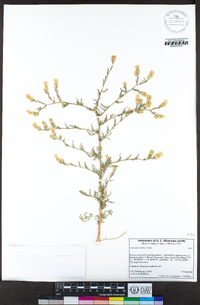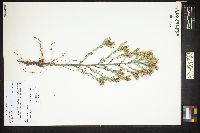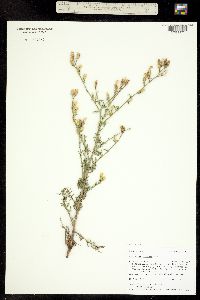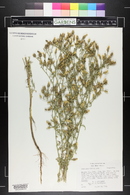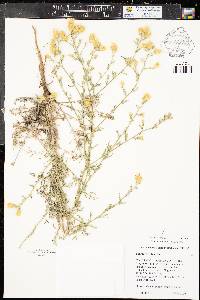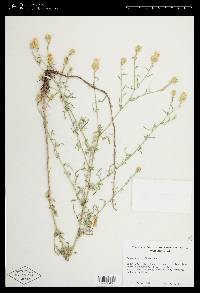Centaurea diffusa
|
|
|
|
Family: Asteraceae
White Knapweed
[Acosta diffusa (Lam.) Soják] |
Annuals or perennials, 20-80 cm. Stems 1-several, much-branched throughout, puberulent and ± gray tomentose. Leaves hispidulous and ± short-tomentose; basal and proximal cauline petiolate, often absent at anthesis, blades 10-20 cm, margins bipinnately dissected into narrow lobes; mid cauline sessile, bipinnately dissected; distal much smaller, entire or pinnately lobed. Heads disciform, in open paniculiform arrays. Involucres narrowly ovoid or cylindric, 10-13 × 3-5 mm. Principal phyllaries: bodies pale green, ovate to lanceolate, glabrous or finely tomentose, with a few prominent parallel veins, margins and erect appendages fringed with slender stramineous spines, each phyllary tipped by spine 1-3 mm. Inner phyllaries lanceolate, ± acute, appendage lacerate or spine-tipped. Florets 25-35; corollas cream white (rarely pink or pale purple), those of sterile florets 12-13 mm, slender, inconspicuous, those of fertile florets 12-13 mm. Cypselae dark brown, ca. 2-3 mm; pappi 0 or less than 0.5 mm, only rudimentary. 2n = 18, 36. Flowering summer (Jun-Aug). Disturbed sites in grasslands, woodlands, open coniferous forests; 100-2200 m; introduced; Alta., B.C., Ont., Que., Sask., Yukon; Ariz., Calif., Colo., Conn., Idaho, Ill., Ind., Iowa, Ky., Mass., Mich., Mo., Mont., Nebr., Nev., N.H., N.J., N.Mex., Oreg., R.I., Tenn., Utah, Wash., Wyo.; Europe. Centaurea diffusa is native to southeastern Europe and casually adventive in central and western Europe. Centaurea diffusa readily hybridizes with C. stoebe subsp. micranthos and is often confused with their fertile hybrid (C. ×psammogena G. Gáyer); the latter can be recognized by its cypselae bearing pappi and having conspicuously radiant heads. Morphologically the hybrids are extremely variable; they may be intermediate or may closely resemble one or the other of the parents. Conspicuously radiant heads and pappi are always present; appendages of the phyllaries are brown to black, or rarely stramineous; spines are absent or short and 2n = 18. Centaurea ×psammogena is known from waste places, roadsides, railway tracks; 50-2500 m; B.C., Ont., Que.; Colo., Mass., Mich., Mo., N.C., Oreg., Tenn., Wash. It may occur spontaneously where the ranges of the parent species overlap; they may also be distributed separately. In mixed stands it replaces C. diffusa by introgression. Hybrids are often misidentified as C. diffusa.
General: Introduced, annual to perennial, 10-80 cm tall; stems 1 to several, much-branched, puberulent and more-or-less gray-tomentose; taprooted. Leaves: Basal and cauline, alternate, the basal and lower cauline blades (often absent at time of flowering) pinnately lobed to twice pinnately dissected, 10-20 cm long, 1-3 cm wide, the ultimate margins entire to pinnately lobed; cauline leaves reduced, the uppermost sometimes entire; minutely hispid and more-or-less short-tomentose; basal and lower cauline leaves petioled. Flowers: Heads solitary or 2-5 in corymb-like arrays; peduncle spiny-winged; involucre somewhat spheric-shaped, 12-17 mm long, phyllaries lanceolate to ovate, conspicuously broad, 2-4 mm wide at the base, spine-tipped, the outer and middle ones with appressed to spreading appendages; disk flowers only, 15-28 mm long, reddish purple; flowers June-September. Fruits: Achene, 2-3 mm long, dark brown, glabrous; pappus absent or less than 1 mm long. Ecology: Disturbed sites, along roadsides, often in sandy or gravelly soils; 50-2500 m (165-8200 ft); Apache, Coconino, Gila, Navajo, and Yavapai counties; western, midwestern, and parts of eastern U.S. and Canada. Notes: See the entry for Acroptilon repens (p. 192) for differences between the two species. Centaurea stoebe ssp. micranthos (spotted knapweed) [=C. biebersteinii, C. maculosa] has also been collected around Flagstaff, although it is less common. It is distinguished by phyllaries that lack a definitive spine, but with dark brown to black tips and margins fringed with slender teeth. The dark brown to black tips gives the appearance of spots, hence the common name. Editor: Springer et al. 2008 Diffusely branched annual or biennial 1-6 dm; herbage sparsely scabrous-puberulent under the thin and deciduous arachnoid tomentum; lvs small, ±pinnatifid, the lower ones deciduous, the reduced ones of the infl mostly entire; heads numerous, narrow; invol 8-10 mm, the middle and outer bracts coarsely pectinate or weakly spinose-ciliate, and tipped with a definite slender spine 1.5-4 mm; fls few, white, seldom yellowish or pinkish or red, the marginal ones not enlarged; pappus none; 2n=18. A weed in waste places, native to se. Europe, and now found here and there in our range. July-Sept. Gleason, Henry A. & Cronquist, Arthur J. 1991. Manual of vascular plants of northeastern United States and adjacent Canada. lxxv + 910 pp. ©The New York Botanical Garden. All rights reserved. Used by permission. From Flora of Indiana (1940) by Charles C. Deam Indiana Coefficient of Conservatism: C = nil Wetland Indicator Status: UPL Coefficient of Conservatism = nil Wetness = UPL |

